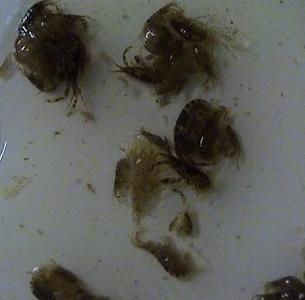8 February, 2004
Everyone seems to have gotten into survival mode. They are hunkered
down, just trying to make it through the day, hoping for better
weather to come. The winds are just as strong as yesterday, gusting
to more than 30 knots. The only salvation is that we have convinced
ourselves that this is about as rough as it will get. It has become
second nature to grab for the rail when you are walking from place to
place. Without a firm hold, the ship could move out from under you,
leaving you lying on the floor.
The sky has cleared slightly. Visibility has improved, but the waves
are so large that it is very difficult to detect the presence of
whales in the vicinity of the ship. We do our best, keeping a look
on the horizon for any sign that would suggest they are in the area.
The heavy seas are still affecting the multibeam and the seismic
streamer. The streamer and gun array tangled throughout the day and
the multibeam data is riddled with errant beams that have to be
edited out before the data is usable. Everything possible is being
done to keep things in the water and working. We hope that things
don't get worse.
By 4:00 AM ship time, we had finished collecting seismic data on a
shot line in the east to west direction. We started a turn north to
head to the next shot line. The combination of the wind and waves
pushed hard on the ship causing it to list to the starboard side. On
the bridge it was like being on a teeter-totter. The bridge is about
fifty feet above the water, and any tilting that the ship experiences
are accentuated there. From the port side, all that you could see
out of the starboard windows was water. It looked as if we were
hanging out over the ocean preparing for a dive. The ship was
listing at about 5 degrees, which is not unusual in high seas. The
engineers are able to correct the tilt of the ship by pumping water
from one side of the ship to the other in the ballast tanks. The
counter weight of the water against the wind and wave levels the ship.
Before the ship could be leveled, the air compressors that power the
air guns began to loose pressure because the oil that lubricates the
machine had sloshed to one side and no air was being pumped. The
pressure to the air guns dropped and then we had to stop shooting
until the pressure was back to normal. In less than a half an hour
we were back up and running, but this was just one more unexpected
problem that arose due to the rough seas.
The afternoon was calmer than the morning but there was still plenty
of rolling to go around. There were many people watching movies and
reading. They were looking for quiet time after their shift.
In the early afternoon, Larry Lawver had been in the engine room and
had been talking to the engineers. He had brought up a paper cup
with Krill that had been caught in the engine filters. Krill are
small crustaceans and look like small shrimp. The Krill that Larry
had brought were all less than a centimeter long. Along the
Antarctic Peninsula the Krill can get to be the size of your thumb or
larger. You can eat them. They taste a bit like shrimp, but have a
waxy after taste.
Krill are the primary food source for Antarctic fish and for baleen
whales like Humpbacks. Humpback whales often use the southern oceans
as migratory routes. Along the way they feed on the Krill during the
summer blooms in October through February. Penguins dine primarily
on fish, and during the Krill blooms, the excrement of the penguins
is red with the undigested chitin from the Krill.
The Krill caught in the filter were at various stages in their life
cycle. We placed some of the collected Krill in a sampling dish with
seawater. Some of the smaller ones were just barely detectable. The
larger Krill could easily be seen moving from one side of the plate
to the other. There are hundreds of Krill in just a milliliter of
sample. Working with the Krill was a nice break from the tedium of
the work and the heavy seas of the past two days.

Krill caught in the ships filters.

Contact the TEA in the field at
.
If you cannot connect through your browser, copy the
TEA's e-mail address in the "To:" line of
your favorite e-mail package.
|
